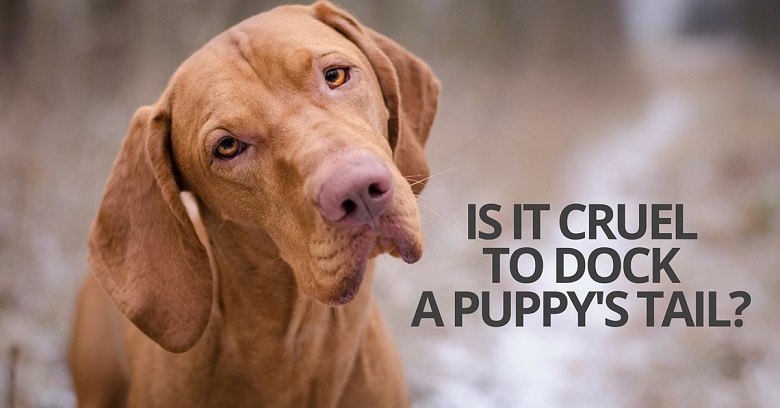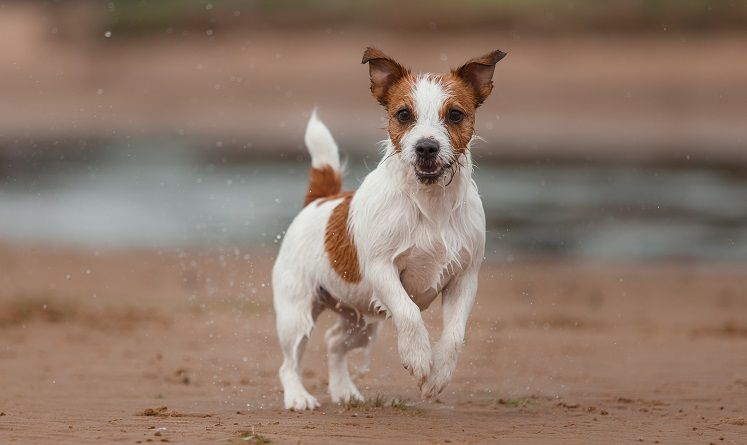Is it cruel to dock a puppy’s tail?
No, it’s not cruel, but it is unnecessary for most dogs.
Docking a puppy’s tail means to remove a portion of the tail, usually when the pup is only a few days old.
Breeds such as cocker spaniels and Rottweilers traditionally have their tails docked in the United States. (Tail docking is illegal in some countries.)
I bring this topic up because we have a Weimaraner puppy. His tail was docked when he was just a few days old.
His tail meets the American Kennel Club’s breed standard for the Weimaraner:
“Tail: Docked. At maturity it should measure approximately 6 inches with a tendency to be light rather than heavy and should be carried in a manner expressing confidence and sound temperament. A non-docked tail shall be penalized.”
I knew our breeder would be docking our puppy’s tail (she does it herself). If that were a problem for me, I would’ve gotten a puppy someplace else.

Why are some dogs’ tails docked in the United States?
You’re going to get a different answer depending on who you ask and what breed you’re referring to.
I’m no breed expert, but here are some straightforward reasons for docking a dog’s tail:
- To meet the AKC’s breed standard (see the Weim example above)
- To help a working dog do her job or to prevent injury on the job. For example, a Weimaraner’s thin, whiplike tail could be split open while working in heavy brush.
- Americans like the look of a docked tail on some breeds because that’s what we’re used to seeing (cocker spaniels, Rottweilers, etc.)
If you’re an expert on a certain breed, I’d appreciate it if you could share why your breed traditionally has a docked tail.
Every breed is different. Here are a few examples:
Tail docking for vizslas as working dogs
The vizsla is a reddish-colored hunting dog bred for pointing and retrieving. The breed has a lot of similarities to a Weimaraner.
According to breeder Florence Duggan, the vizsla’s tail is traditionally docked in the United States for safety reasons.
“A long tail could easily get broken while running through thick underbrush and in a heavily wooded area,” she said. “The same reasoning is used for the removal of dew claws.”
Now, injuring the tail in the field might sound silly if you never take your dog hunting. Until you’ve seen a serious tail injury like I have, I think it’s hard to understand this can be a real concern for some breeds. More on that below.
Tail docking for Parson Russell terriers
Annette Gilliam is a breeder of Parson Russell terriers, another breed with a traditionally docked tail in the United States due to its history as a working dog. Her dogs are not pictured, but you can view her web site here.
She said historically the Parson Russell terrier was developed to go on fox hunts in England.
The “terrier-man” would carry the terrier in a bag while riding horseback running with the fox hound, she said. When the fox would go into a hole in the ground to hide, the terrier-man would take the terrier out and it would run into the hole after the fox to make it come out.
She said if the fox and the terrier did not come out of the hole, the terrier-man would dig and pull the terrier out by the tail. This is why they wanted the tail to be as long as a man’s hand.
Today, it’s illegal to use dogs for fox hunting in England, and Gilliam said she doesn’t know anyone who goes fox hunting in the U.S.
“It is not physically necessary to dock tails now anywhere,” she said. “Some people like the look so they still do it.”
How is tail docking typically done?
Gilliam said she docks the Parson Russell terrier pups herself when they are between 3 and 5 days old, although she sometimes leaves tails undocked depending on who is buying the puppies.
“You clamp a hemostat where you want to dock, wait 1 to 2 minutes for circulation to cease, then cut with sharp scissors below the hemostat,” she said. “They never bleed.”
Is this painful for the puppies? I asked.
“Some puppies yelp when the hemostat is first applied, but then they stop,” she said. “Some don’t notice. They don’t feel the cut because the nerves are numbed by the hemostat.”
This isn’t the only way it’s done.
Our puppy’s breeder sends me pictures of the pups every day, and by day 3 the little guy had a band tightly bound around the tip of his tail.
I have to say this was a bit traumatizing for me at first. But a few days later, the tip appeared to have already fallen off (or maybe it was cut off), seemingly no big deal.
She sends me videos of the puppies snuggling with mom almost daily, and they always appear peaceful, fat and happy.
Tail docking through a veterinarian
Duggan said some vizsla breeders also dock the tails themselves but most use the services of a vet and have tails docked and dew claws removed at the same time.
I asked her if vets typically use anesthesia for the tail docking procedure.
“Some vets do use a local anesthetic,” she said. “But many feel that if it is done at 3 days of age the pain is minimal and there is no need for anesthesia. The risks of being anesthetized outweigh the minimal pain.”
Gilliam also knows of breeders who prefer to go through a veterinarian and some who prefer to do it themselves.
“I think that people who don’t breed much are more likely to go to a vet or have an experienced breeder friend do it for them,” she said.
In her case, she said she had a friend and mentor who would come and do the tail docking until she learned the technique herself.
The time I witnessed a tail injury
One of the reasons commonly cited for tail docking is to prevent injury in the field for hunting dogs. I think this is a legitimate concern, depending on the kind of work you plan to do with your dog.
I’ve never witnessed a dog being injured in the field (I don’t hunt), but years ago I worked at a boarding kennel and one of the dogs there – a yellow Lab with a whip of a tail – would hit her tail on the chain link sides of her pen until it bled.
We tried to protect her by hanging blankets, but one afternoon I walked by her pen and noticed blood everywhere and as I got closer I saw she had split the tail so that the top 3 inches was dangling, split right through the bone.
Imagine if you were to chop down a tree, striking it through the middle and for a split second it hangs before dividing in two.
The top 3 inches of her tail was dangling, bone exposed.
I took her to the vet of course, trying to hold her tail at the base in the lobby to keep her still.
The vet took one look at the pup and immediately said the tail would have to be amputated; that was the first time I heard the term “happy tail.”
I’ve heard it many times since.
My own dog Ace hits his tail on the walls by the front door and about every two years or so blood splatters everywhere. It’s never a big deal and never requires veterinary attention, but he does tend to injure his tail.
Maybe it’s a Lab thing. Funny, Labs are not a breed with traditionally docked tails.
My opinion on tail docking
I’m not trying to justify tail docking one way or the other. I think it’s a matter of individual opinion and looking at your lifestyle with your own unique dog.
Most of the time, tail docking is purely cosmetic (and silly). But like I said, our puppy’s tail is already docked, and I really could care less. If it were up to me, he’d have a long tail but I respect our breeder’s wishes.
To each her own.
Update: I do want to mention one final point. One of my regular readers Sean pointed out in the comments below that dogs use their tails to communicate!
Their tails are so important for expressing probably even more than we realize, especially when they’re greeting one another. I agree with him this is an important factor to consider and a strong reason many dog lovers oppose tail docking.
OK, now I’d love to hear your thoughts …

What do you think? Is it cruel to dock a puppy’s tail? Or is it still important?
Let me know!
Related posts:
Do rescues spay/neuter puppies too young?
Should I have my cat declawed?
Is spaying and neutering the right choice for my dog?
What you need to know about ear cropping – (from PuppyLeaks.com)


Denise
Sunday 31st of May 2020
For those bringing up that dogs use their tails as a way to communicate with other dogs, how about dogs that are born with naturally short tails? My breed can be born with all different lengths of tails, crooked tails, kinked tails ... One of mine was born with a naturally short tail, one was a rescue so I’m not sure but I think her tail was naturally the length of about a half tail, 3 others had docked tails. None of them have a problem communicating with other dogs, nor do they have problems with balance - they are athletes who compete in agility.
Jessica Lundin
Monday 5th of June 2023
@Denise, yeah that would be like if a dog comes out disabled in some way every dog should be mutilated the same way. "Born with" is one thing. Obviously they have to live like that and make it work and they do just fine in doing so. That cant be helped but to purposely remove it is a choice made by a person and not one made by the dog itself who would most likely prefer to just keep it. Obviously I know the dog wouldnt have a say so because they cant speak but im sure if they got to choose they wouldnt choose that.
Tony Hutchins
Tuesday 11th of August 2020
Yeah, the operative words you’re using there Karen, I mean Denise, Are “born with”
randi h sinel
Thursday 12th of March 2020
I would like to have a Weimaraner pup with an undocked tail. I’ve had Weimaraners before and never really thought about the process or reasons. But I am more aware of the issue now and I believe the reasons for docking are mostly about official breed requirements which were established too long ago to be relevant now.
The thing is, it’s near impossible to find a good breeder who doesn’t dock Weimie tails. I suppose I could request that they randomly choose a puppy at 3 days old to not dock but my belief in choosing the right puppy is too strong. And you can’t know a puppy at 3 days.
Lindsay Stordahl
Thursday 12th of March 2020
I would recommend docking a weim's tail to prevent injury from wagging it on furniture, walls, etc. Their tails are like whips.
Jason D Johnson
Friday 24th of November 2017
Saying it's not cruel doesn't actually make it not cruel. It's not for you to decide on when mutilation isn't cruel. All mutilation is cruel. The benefits never outweigh the costs to the dog, even in your examples.
Lindsay Stordahl
Saturday 25th of November 2017
We have different viewpoints on this. Thanks for sharing your take on it.
Bruce Bolduc
Sunday 4th of December 2016
Our Elly is a Patterdale terrier, which is related to the Parson Jack Russell (just paintshop the picture black - she looks like a baby black lab but is a terrier). She is bred as a fox hunter as the Parsons are. Her tail was docked when we got her (she is a rescue) and she is still sensitive about us touching it or trimming the hair on the end. It's a sad tail, but she won't tell us it. She wags her stubby tail, which is so cute but I think that she would have been happier with a full tail.
Jessica
Wednesday 2nd of March 2016
I have a german shorthaired pointer. The breeder docked the tail when she docked all of the littermates. So, i didn't really have a say, and didn't really have an opinion on it at the time. My dog is particularly accident prone and has injured every limb at least once, everything from scrapes to sprains to needing stitches. Her short hair provides very little protection against the brushy areas we run in and I am certain if her tail wasn't docked, she'd have been to the vet for tail repairs. So I'm for it, especially for the shorter haired breeds who tend to run wild once they get outdoors.
Lindsay Stordahl
Wednesday 2nd of March 2016
Very interesting. Thanks Jessica!